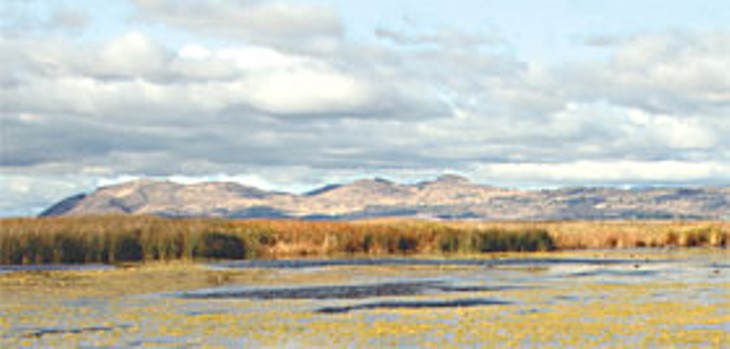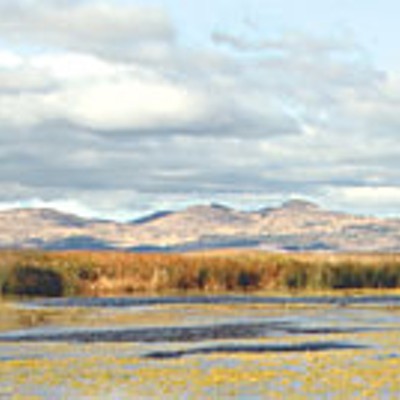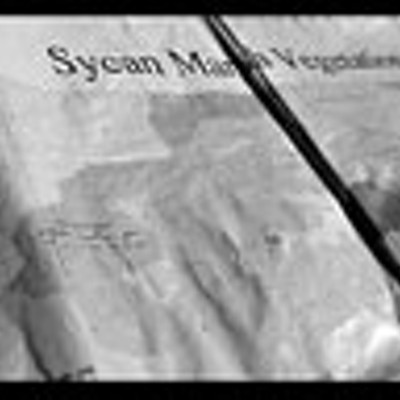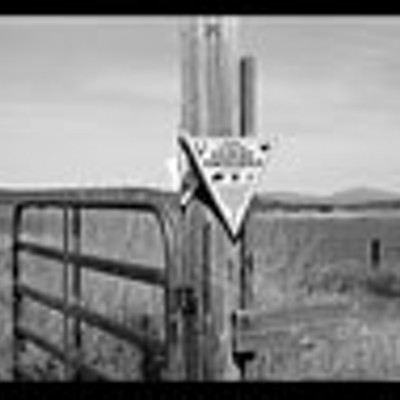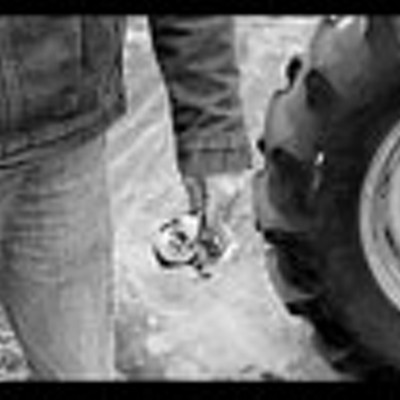[
{
"name": "Top Stories Video Pair",
"insertPoint": "7",
"component": "17087298",
"parentWrapperClass": "fdn-ads-inline-content-block",
"requiredCountToDisplay": "1"
}
]
The over 4,000 cattle being grazed sustainably at Sycan Marsh, located in the northeastern corner of the Klamath Basin, have no idea how much science has gone into the cud they’re chewing. But Craig Beinz does.
At first glance, Beinz looks more like a rancher than an ecologist, but underneath his spotless cowboy hat and behind his bushy, graying mustache is a man who’s invested 30 years into this region. Beinz first moved to the Upper Basin to serve as the lead biologist for the Klamath Tribe, a position he held for 20 years. In 1999, he took a job with The Nature Conservancy, managing Sycan’s 30,000 acres in partnership with the ZX Ranch, one of the largest cattle ranches in the United States.
At Sycan Marsh — the entire area of which is designated as critical habitat for bull trout — Beinz has proven that efficient use of water is not only good for the environment, but good for business as well, to the tune of approximately $5 million in net profit a year.
“At Sycan we’re showing that you can do grazing in a more sustainable manner than what we did 10 years ago,” Beinz said. “Can we do that across the globe? Maybe.”
But Beinz doesn’t feel the need to proselytize, even to those farmers working the land an hour-and-a-half drive south of here in the Klamath Project, where the threat of another water cutoff is a constant concern for them, according to Greg Addington, executive director of the Klamath Water Users Association (KWUA). It’s no secret that what’s going on at Sycan Marsh is a litmus test for balancing ecology with sustainable land management elsewhere in the Basin. In some cases, Project farmers whose families have been growing crops here for generations are already choosing to embrace less conventional farming methods, either on their own or with federal assistance. But change is slow to come.
The upper Sycan watershed only contributes four percent of the water that flows into Upper Klamath Lake, and even though that seems like a small percentage, it doesn’t take long in the Basin to realize that every drop of water counts.
“What we do here in fact probably benefits what they’re doing there, because the water they’re pumping for their project probably comes from this part of the watershed,” Beinz said.
As water flows out of Sycan Marsh and down into the Sprague River it begins its meandering journey into Upper Klamath Lake, where it’s diverted onto farmland in the Lower Klamath Lake area via the “A” canal. At the same time, water from the Lost River is making its way onto ranches in the Poe Valley, east of the city of Klamath Falls, and then down into Tule Lake in California, where that water is used multiple times before it’s eventually pumped over to the Lower Klamath Lake area, reclaimed for irrigation again and then pumped twice more to higher elevation and out to the Klamath River, eventually debouching into the ocean near Requa in Del Norte county, 250 miles later.
The Upper Klamath Basin, which straddles Oregon and California, covers 5.6 million acres and includes six National Wildlife Refuges, providing habitat for millions of birds and a handful of threatened or endangered species. It’s also home to 1,400 farms and ranches, which depend on limited water resources to raise cattle or cultivate crops like potatoes, mint, alfalfa and grains. The Upper Basin and the Lower Basin, which extends over three California counties — Trinity, Del Norte and Humboldt — are connected by an artery of water: the Klamath River. Water quality and water flows in the river, which produces the third largest salmon run on the west coast, are directly affected by agricultural practices in the Upper Basin. As farmers and ranchers begin to act more sustainably on operations upstream, the hope is that downstream ecosystems will benefit.
If the Klamath Basin were a novel, water would be its protagonist. This place was once known as “the land of lakes.” That’s what brought farmers here in the beginning of the 20th century to reclaim the Basin for agricultural purposes. Who would have thought that in the 21st century a lack of something once so ubiquitous would be at the heart of a conflict that has pitted farmers against the federal government, fishermen and tribes? For the past two years these disparate stakeholders have been hammering out their differences. During that process they’ve discovered, and relied upon, their myriad similarities to reach consensus on tough issues. In November of this year, that group of 26 diverse stakeholders will deliver their recommendation to the Federal Energy Regulatory Commission (FERC) on a variety of issues that will influence the future of coastal fishermen and basin farmers.
In the meantime, farmers and ranchers here are making changes — changes which in 2001, when the Bureau of Reclamation ignited a rebellion by shutting off irrigation water to the Basin, many farmers would have scoffed at.
Craig Beinz, who manages Sycan Marsh for The Nature Conservancy, is proving that ranching in the Klamath Basin can be both profitable and sustainable.
Steve Kandra, a farmer in Tulelake, Calif., is a prime example of that. Standing beside an irrigation ditch on the approximately 500 acres he farms at the edge of the Tule Lake National Wildlife Refuge, in an area he calls “the nursery” because of the herd of mule deer that come here each fall to drop their fawns, he explained to me the compromises he’s made — at his own expense — to balance his farming needs with those of wildlife.
In addition to high-efficiency irrigation and tiles sunk in the fields to better recycle the water, Kandra is particularly proud of the wetland habitat he’s constructing for waterfowl, as well as the various ditches he let the reeds take over— what he calls “buffer zones,” designed for nesting birds. He’s also growing safflower in the four corners of one his fields for birds to feed on. In total, he devotes about 10 percent of his land, or 56 acres, to benefit wildlife.
There are no direct economic incentives for what Kandra’s doing, unlike some of his neighbors who participate in the U.S. Fish and Wildlife Service’s “walking wetland” programs. In return for creating temporary wetlands on their property, farmers get to cultivate crops on drained wildlife refuge land. “The only compensation I’ve got,” Kandra said, “is my goodwill.”
But Kandra’s feelings toward the wildlife on his property weren’t always the same. “I used to try to keep them out,” he said. “Impossible. You just can’t do it. So what I’m trying to do is manage it.”
According to Kandra, the changes he’s made would make his father, also a Basin farmer, roll over in his grave.
But this land has change written all over it. Where we stood on Kandra’s 540 acres is just miles from Lava Beds National Monument, famous for being the stronghold of Captain Jack, the Modoc Indian who took refuge here with 54 other Indian men and their families during the Modoc War of 1872-73. Captain Jack and his ragtag group held off U.S. Army forces numbering almost 10 times their strength for five months. That Native Americans were eventually controlled, pushed off their tribal lands and forced onto reservations, is now considered an injustice; then, it was just another chapter in the history of Manifest Destiny. Reclamation projects — the redistribution of water in order to cultivate crops on formerly unusable lands — were another way of shaping the West to serve our own purposes. In 1906, when Reclamation Service engineers began construction of dams and canals to divert water to arid areas and drain lakes in order to make the Klamath Basin fit for agriculture, they described it as “one of the most complex problems” they’d ever tackled. The land, like the Indians, didn’t want to be tamed.
Kandras have been dealing with basin complexities since the 1940s. That’s when Steve Kandra’s grandfather bought this particularly fertile patch of dried-up lakebed. But agricultural practices in today’s Basin are very different from those in the basin of yore.
After the 2001 water cutoff — when Kandra stood on his fields literally footsteps from Tule Lake, but unable to the use the water to irrigate his crops — he realized he had to do things differently in order to stay in business. Now he talks about “predation” of ducks and what makes good wetlands. He also shares vocabulary in common with Troy Fletcher, former executive director of the Yurok Tribe who has been active in the FERC settlement talks. “We need to be looking at how all of our activities can be done so that we sustain all our communities ,” Kandra explained. Those communities include basin farmers, coastal fishermen and Indian tribes.
“My personal philosophy has evolved: Don’t fight ’em, join ’em,” he said, referring to the wildlife. He could have just as easily meant the 26 disparate stakeholders involved in the talks.
In the future, Kandra predicts that smaller family farms will end up being consolidated as costs increase due to rising power rates (a result of possible dam removal on the Klamath River). “I’ve consolidated three or four farms and now someone is going to consolidate me because of scales of economies,” he said. And when that happens, the face of the Basin will change again: “I have an emotional attachment ... Corporate farms are going to look at it totally different,” he said. Kandra’s children are not interested in farming so he’s passing the trade along to some younger neighbors of his.
In the meantime, “All I want to do is have a little recognition on this farm,” Kandra said. “Let me farm the way I need to on the rest of it ’cause I’m providing for the critters on the other lands.”
Environmentalists like Steve Pedery at the nonprofit group Oregon Wild, in Portland, see things differently. Pedery wants agriculture off of refuge lands altogether. Walking wetlands, he explained in an email last Thursday, are “better than nothing, but [it’s] a little ironic that land which was set aside by FDR in the 1930s to protect wetlands for wildlife is now reduced to temporary wetlands, and even then this occurs only when commercial agricultural operations feel generous enough to allow this taxpayer-owned land to be temporarily managed for wildlife.”
What Kandra is doing is different — he’s creating a wetland at his own expense. But some of his neighbors farm on wildlife refuge land.
Pedery believes that the “cheapest and easiest way to improve water quality” on the Klamath River, and thereby benefit fish species is by “expanding wetlands in the National Wildlife Refuges.” But this is too radical for other stakeholders, which is why Oregon Wild and another environmental group, WaterWatch of Oregon, have been disinvited from settlement talks. A settlement will be reached in November, but will it come at the cost of true consensus?
John and Jeanne Anderson, ranchers in the Tule Lake area, have been ostracized from the KWUA, which represents 1,400 ranches and farms in the Klamath Project, for their radical views. Among those is the belief, like Pedery’s, that no farming should be allowed on lands leased from wildlife refuges.
But the Andersons have come to this conclusion from another angle. Though they readily admit that wildlife would benefit from removing agriculture from lease lands, they also note that as landowners, rather than tenant farmers, they are negatively impacted by more land for rent. “There are people who can’t get their places rented for a very good price on the private ground because they’re competing with too much ground that the federal government has on the refuge,” Jeanne Anderson explained last Thursday in an interview at the Andersons’ home.
“I think it’s time they don’t farm the refuge anymore,” she continued. “There’s plenty of private ground out there that’s not getting rented adequately ... besides the revenues will stay in the community. And the revenues for the refuge don’t stay here ... they go to the government.”
After losing half a million dollars as a result of the 2001 water cutoff, the Andersons called for drastic changes in the way things were done in the Basin. They suggested a program that would pay farmers to not use water, which became known as the water bank. Initially, the KWUA belittled the idea, but eventually they “grudgingly acquiesced,” according to Jeanne Anderson.
John Anderson said that in 2003, at a meeting at the Klamath Falls fairgrounds, someone from the KWUA stood up and, looking defeated, apologized for the fact that there was going to be a water bank, but “... as soon at he hit the end of the sentence, the whole room went to the back of the room and there’s this table there with applications lined up, and all these applications got wiped off the table,” Anderson said, laughing. But his laughter was bittersweet. It’s apparent from listening to the Andersons that after the cutoff, the Basin community wasn’t ready for their proactive approach, and though change is happening now, it may be too little, too late.
Still, the Andersons have managed, like others, to find a certain balance between their needs and the Basin’s limited resources. They have given up cultivating water-sensitive crops like sugar beets and mint and have turned to ranching. They grow alfalfa, which has long roots and will survive in case of another water shortage.
As for eventual changes to farming practices on the National Wildlife Refuges, nothing will happen, according to the Andersons, so long as the Bush administration is in office. And the Andersons are Republicans. “Ultimately, Democrats are going to come to power, and they [the farmers] are going to lose those lease lands,” Jeanne Anderson said. “There’s such a green movement out there, and that’s where the votes are, and I think ultimately those votes are going to win and you’re going to see farming off of all refuges.”
The Andersons were ahead of the curve on the water bank program and were punished by those who preferred the status quo at the time. Are they right again in asserting that farming will eventually move off the refuges? Steve Kandra is hedging his bets in the opposite direction, and he’s hoping that by proving that farmland can be managed more responsibly, habitat for wildlife and crops for farmers will be able to coexist in the Tule Lake area for a long time to come.
Andersons have farmed in the Klamath project for over a century now, but as for the next generation — their two daughters — it may be time to move on. “We’re not gonna have our kids farm,” Jeanne Anderson insisted. When asked what they would do, she was certain of only one thing: “Anything but farm,” she said.
In a small town on the Oregon-California border that was originally settled by Czech immigrants, Bill Kennedy is waiting for me in the Malin diner. Over lunch last Thursday, he explained how his father, who moved to Poe Valley in the 1970s to ranch, felt strongly that ranchers and farmers ought to take into consideration the wildlife with whom they share their land. This issue is particularly important in the Klamath Project because it’s a major stop-off for migratory birds on the Pacific flyway. Eighty percent of all the migratory birds in the West stop here.
That’s why Kennedy’s father and Dayton O. Hyde started Operation Stronghold. (Hyde, once a Basin farmer, is famous for his books about man’s relationship with nature, like Don Coyote, which traces Hyde’s unlikely friendship with a coyote.) Operation Stronghold promotes sustainable land management techniques and the development of wildlife habitat on ranches and farms. In many ways, the tenets of Operation Stronghold mirror what Craig Beinz is doing at Sycan Marsh. Both are ways of balancing the needs of nature with man’s desire to bring it under his control and make it productive.
After lunch, I followed Kennedy back to his 4,800-acre Lost River Ranch — one of the last large-scale, contiguous ranches on the Project. A placard at the entrance informs you that you’re entering Operation Stronghold. The name makes it sound like it’s a military operation but the reality is far more pacific — there’s absolutely no hunting allowed on the ranch. Kennedy has about 1,000 head of cattle this year, in addition to the over 400 different wild animal species that consider this place home. Even Kennedy’s oversized pick-up truck is part of the solution. “I just filled up with biodiesel,” he said.
“The main emphasis [at Lost River Ranch] is to provide ideal habitat for wildlife and in our own situation ... we have a critical location for waterfowl,” Kennedy explained. “And we’re able to give waterfowl, number one, privacy for nesting, feeding and rearing their young and, number two, a place to recuperate and store their body fat for their fly off in the winter.”
Driving down the washboard road that meanders through the Lost River Ranch, Kennedy pointed out high efficiency irrigation systems he’s installed, as well as patches of uncut, organic grain he’s left for the birds to feed on. He’s also done work on the hill to the north of the ranch. By thinning 80 acres of juniper trees he’s created more wildlife habitat. The “wildlife just went bonkers,” he said. “The deer came, the birds could fly through the trees, and we released a spring.” He calls this forward-looking way of running his cattle operation a “watershed-wide approach.” He pointed out that it doesn’t necessarily make economic sense, “but it’s probably the best thing you can do for the watershed,” he said.
Kennedy has also sunk wells on his ranch to tap into ground water resources. In addition to being able to use that water for the cattle operation in case of another water cutoff, it’s also a way to “enhance wildlife habitat in extremely dry years,” he said.
Like all the farmers in the Project, Kennedy is concerned about rising energy costs and he’s interested in developing sources of renewable energy like low-head hydroelectric power (using extremely small drops in elevation to generate hydro electricity). But it still doesn’t make economic sense yet. In a few years it may. Increasing energy costs won’t only make family farming less viable, it will also affect wildlife, he said. “If you put economic pressure on producers, they can’t afford to participate in wildlife enhancement,” Kennedy warned.
Another threat to wildlife will be the proliferation of smaller parcels. As more city dwellers move to the basin and purchase five acres and a horse, the landscape will change for the worse. “Wildlife needs a continuous habitat. They don’t do very well when you divide things into little ranchettes,” Kennedy said. Additionally, the water usage by smaller landowners won’t necessarily be more efficient than farmers who understand just how scarce their precious resource are.
But the water issue, according to Kennedy, isn’t as simple as conservation being good, use being bad. “For the most part we see the need to enhance our infrastructure and part of the enhancement doesn’t necessarily have anything to do with water conservation,” he said. “It may be contrary to water conservation, but enhance wildlife habitat.”
After we’d circumnavigated Poe Valley in his truck, passing dairies and organic chicken farms along the way, Kennedy confided in me his biggest concern at the moment: He doesn’t have Internet access in his home and he wants to set up a Wi-Fi transmitter at the Lost River Ranch headquarters so that he can use iChat to communicate with his college-aged daughter. The Lost River Ranch, an important stop on the Pacific flyway, may soon become a hotspot on the information superhighway.
Luther Horsely, a farmer in the Lower Klamath Lake area, pays the rent on some of his fields unconventionally. He doesn’t cut a check at the end of the month. In fact, not cutting is part of the deal. He leaves 40 percent of his barley crop for the birds.
What Horsely does is called lease-share farming. It’s a program managed by the U.S. Fish and Wildlife Service (USFWS). USFWS contracts farmers to cultivate land on the Lower Klamath National Wildlife Refuge and requires them to leave a certain percentage of their crop for migratory birds.
It was obvious from driving around with Horsely last Wednesday that the arrangement isn’t just economical for him — he’s become rather attached to the animals he services.
“I really feel like I’m lucky because there are people who come from all over to look at the wildlife and I just get to farm right in the middle of it all the time,” Horsely said as we drove down past his fields and then out around wetlands in the National Wildlife Refuge, which was the first ever waterfowl refuge in the United States, established by President Theodore Roosevelt in 1908.
Horsley is a strong proponent of lease-share farming. “I think that the wildlife really benefit from what I do,” he said as we looked out across wetlands filled with pelicans and ducks. “Up around my house in 2001, when we were shut off, it was eerie quiet ... everything was just dead. A lot of wildlife benefit from what I do and depend on me.”
Horsley understands that in order for farming to continue in the Lower Klamath Lake area, it needs to be done sustainably. “If there’s something I’m doing that will hurt the environment,” he said, “I’ll stop.”
But if there ends up being less farming in the Basin in the future, Horsley fears the worst. “On the private lands, without agriculture, my place become a Costco or a Wal-Mart parking lot with a suburban area around it and there goes the open spaces and the wildlife and joy, because there’s not much habitat in a Wal-Mart parking lot except for seagulls,” he said.
Since farmers generate their livelihood from the land, they’re sensitive to things that affect it adversely, Horsely said. He stopped the truck to point out a young coyote jumping through the reeds and bushes.
“We have to be sustainable, and you can’t do that by raping the environment,” he said. “That’s why I’m pretty exited to see the FERC settlement talks. I don’t know if we’ll ever agree on anything but the neat part is that we’re talking. It’s fun to talk to people like Troy Fletcher ... We were eating lunch one time three or four years ago here and he said, ‘We’ve been suing each other and we haven’t helped the watershed one bit.’ So we decided there’s gotta be a better way.”
Looking west across Sycan Marsh, you can see Yamsi Mountain in the distance ( Yamsi is another well-known book by Dayton O. Hyde). The Basin is full of circles — both hydrological and epistemic.
I asked Craig Beinz how he would suggest untying the Klamath knot. Not the knot that scientists use to describe the unusual geological formations in the Klamath region, and after which author David Rains Wallace named his well-known book, but rather the mess caused by the intersecting interests of farmers, tribes, coastal fishermen and environmentalists who are all after the same thing: water.
Beinz just laughed. He knows this system from the headwater to the mouth, but the only thing he’s sure of is that the efforts he’s making on behalf of The Nature Conservancy at Sycan Marsh seem to be bearing fruit. As for the rest, no comment. On a global scale, things are being complicated by global warming, he explained, by increasing temperatures and drought. As an individual he’s trying to decrease his carbon footprint. His truck, he said, is his last holdout, but there’s no other way to navigate the gnarly dirt roads that snake through the marsh.
“In situations where we have crisis, it’s our community that’s the solution,” Beinz said. In the meantime, Beinz is trying out a few things on Sycan that may one day prove useful downstream. He’s working with the Oregon Forest Service to increase fish connectivity in streams at Sycan Marsh and in the greater Frémont-Winema National Forest. By opening up water passageways for fish, flows are up and water temperatures have gone down. And while ameliorating fish habitat, he’s also managed to double — over the past 10 years — the number of cattle ZX Ranch grazes.
As for untying that knot, Beinz said, “The complexities of life — climate, temperature, grazing — there aren’t rules. You just really try to look at it every day, every year, try to work it out.”
Pictured above: Rancher Bill Kennedy owns and operates Lost River Ranch in Poe Valley as a part of Operation Stronghold, a program founded in the 1970s by Kennedy’s father and author Dayton O. Hyde. Operation Stronghold encourages sustainable land management practices as well as providing habitat for wildlife.
more from the author
-
Big Fish
- Jul 10, 2008
-
Lost in Translation
36 Chinese students and their Humboldt hosts take a walk in the woods
- Jul 10, 2008
-
Slow Burn
Wildfires around Orleans are testing how well a community, an Indian tribe and a government agency can work together
- Jul 3, 2008
- More »
Latest in News
Readers also liked…
-
Through Mark Larson's Lens
A local photographer's favorite images of 2022 in Humboldt
- Jan 5, 2023
-
'To Celebrate Our Sovereignty'
Yurok Tribe to host gathering honoring 'ultimate river warrior' on the anniversary of the U.S. Supreme Court ruling that changed everything
- Jun 8, 2023
